|
Agriculture > Plantation
Crops > Arecanut (Areca catechu L.)
|
|
|
|
Introduction
|
|
The arecanut palm (Areca catechu
L.) is one of the important commercial crops of India. The crop is mainly grown
in the states of Kerala, Karnataka, Tamil Nadu, Assam, West Bengal, Meghalaya, Maharashtra,
and Andaman & Nicobar group of Islands. The economic produce is the fruit called
betelnut or 'supari' which is used mainly for mastigatory purpose. Arecanut is an
essential ingredient of ‘gutka’ and ‘pan masala.’ It is consumed both as a raw/ripe
nut (adaka or kacha tamul), as dried ripe nut (chali supari) and as semi-mature,
cut and processed varieties `Bateldike’ or `Kalipak’.
Arecanut or betlelnut is an extensively
cultivated tropical palm. It is a tall-stemmed, erect, reaching varied height, depending
upon the environmental conditions.
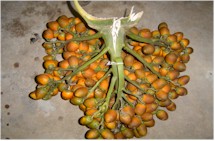
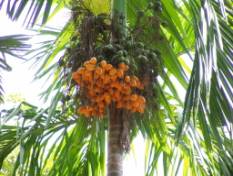
|
|
Climate & Soil
|
|
Arecanut grows well within the temperature range of 14ºC and 36ºC and is adversely
affected by temperatures below 10ºC and above 40ºC. Extremes of temperature and
wide diurnal variations are not conducive for the healthy growth of the palms. It
can be grown in areas receiving annual rainfall of 750 mm to 4,500 mm. In areas
where there is prolonged dry spell, the palms are irrigated. Due to its susceptibility
to low temperature, a good crop of arecanut cannot be obtained at an altitude of
more than 1000 m MSL.
The largest area under the crop is found in gravelly laterite soils of red clay
type. It can also be grown on fertile clay loam soils. Sticky clay, sandy, alluvial,
brackish and calcareous soils are not suitable for arecanut cultivation.
|
|
Varieties
|
|
Top
|
|
Distinguishing characters of promising cultivars and released varieties of arecanut
|
Cultivar/Variety
|
Growth habit
|
Shape & size of nut
|
Yield Chali (kg/palm)
|
Year of release
|
Recommended Agro climatic area
|
|
Promising cultivars
|
|
SK Local
|
Tall
|
Round and bold
|
2.00
|
|
Northern Kerala
, Kasaragod & DK,Karnataka
|
|
Thirthahalli
|
Tall
|
Small and elongated
|
2.60
|
|
Malnad areas of Karnataka
|
|
Sagar
|
Tall
|
Small and round
|
2.25
|
|
Shimoga and Uttara Kannada of Karnataka
|
|
Shriwardhan
|
Semi-tall
|
Round and medium
|
2.00
|
|
Coastal
Maharashtra
and Karnataka
|
|
Hirehalli
|
Tall
|
Round to oval medium
|
3.20
|
|
Maidan Parts of local Karnataka
|
|
Released varieties
|
|
Mangala
|
Semi tall
|
Round & small early bearing
|
3.0
|
1972
|
Coastal Karnataka and Kerala
|
|
Sumangala
|
Tall
|
Oval & medium
|
3.28
|
1985
|
Karnataka and Kerala
|
|
Sreemangala
|
Tall
|
Round and Oval
|
3.18
|
1985
|
--do--
|
|
Mohitnagar
|
Tall
|
Oval to round Homogeneous medium
|
3.67
|
1991
|
West Bengal
, Karnataka & Kerala
|
|
Calicut-17
|
Tall
|
Elongated and Sturdy & bold
|
4.37
|
1995
|
Andaman & Nicobar Islands
|
|
SAS-1
|
Tall
|
Round and compact medium canopy
|
4.60
|
1995
|
Only valleys of Sirsi, Karnataka
|
|
|
Cultivation Practices
|
|
Top
|
|
Arecanut is propagated only by seeds. Being a perennial crop, adequate care should
be taken in selecting the planting material. There are four steps in selection and
raising of arecanut seedlings viz., selection of mother palms, selection of seed
nuts, germination and raising the seedlings and selection of seedlings.
Selection of site:
Select sites with deep well drained soil without high water table. Provide adequate
irrigation facilities
Selection of mother palms:
The criteria for the selection of mother palm are; early bearing, regular bearing
habit, semi tall to dwarf stature, large number of leaves on the crown, shorter
internodes and high fruit set.
Selection of seed nut:
Fully ripened nuts from middle bunches having weight of above 35 g should be selected
during mid season. The nuts selected should float vertically with calyx-end pointing
upwards when allowed to float on water. These nuts produce the seedlings of greater
vigour.
Nursery techniques:
Sow selected seed nuts soon after harvest in nursery
bed with stalk-end up and with a spacing of 5-6 cm. Cover the seed nuts with sand
and irrigate daily. Transplant 90 days old sprouts having 2-3 leaves to the secondary
nursery. Prepare secondary nursery beds of 150 cm width and convenient length. Apply
cattle manure @ 5 t ha-1 as basal dose. Transplant sprouts at a spacing of 30 cm
x 30 cm. Provide shade by growing banana, Coccinia indica etc or by means of artificial
pandal. Plant banana in advance at a spacing of 2.7 m x 3.6 m when it is grown as
a shade crop. Provide irrigation during hot and dry periods and drainage during
monsoon. Periodical weeding and mulching are necessary.
Selection of seedlings:
Select good seedlings for transplanting in the main field when they are 12-18 months
old. Selection of seedlings can be based on the selection index. Multiplying leaf
number by 40 and subtracting the seedling height gives the selection index. Select
seedlings with higher selection index values.
Example: Seedling height = 90 cm, Leaf number = 5 Selection index = (5 x 40)–90
= 110 (If for instance, index values range between 50 and 150, select seedlings
with higher values to the extent possible). Uproot the seedlings with the ball of
earth attached to them for transplanting.
Note: Plant characters such as girth at the collar one year after transplanting
and number of nodes two years after transplanting are highly correlated with yield.
Removal of plants with poor collar girth and lesser number of nodes one and two
years after planting respectively, will help to increase the yield potential of
plantations.
Field Planting
Selection of site and layout:
The crop thrives well in humid areas protected well against hot sun and heavy wind.
Since the areca palm does not withstand either water logging or drought, the site
selected should have proper drainage and adequate source of water for irrigation.
Arecanut palm cannot withstand extreme temperature and exposure to direct sun. So
the site selected should have protection from southern and western sides. The soil
depth and the depth of water table are other two parameters to be considered while
selecting the site. The soil should be deep (preferably not less than two meters)
and water table should be sufficiently low for better root development. Aligning
the rows in north-south direction with a deviation of 35º towards south-west lowers
the incidence of sun-scorch.
Spacing:
This depends on the rooting pattern of the crop along with the fertility and depth
of the soil. The studies conducted at different places with different spacing have
revealed that a spacing of 2.7 m X 2.7 m is optimum for arecanut. This was justified
by the root distribution studies also.
Planting:
Dig pits of size 60 x 60 x 60 cm and fill up with rich top soil to a level of 15
cm from the bottom. Plant seedlings at the center of the pit, cover with soil up
to collar level and press around. In well-drained soils and in the fields
where proper drainage can be provided, deep planting is preferred. Deeper planting
provides a firm anchorage and larger volume of space for root development. In areas
where water table is high, shallow planting is preferred. Thus in well-drained soils,
planting at a depth of 90 cm is recommended and in heavy soils planting at a depth
of 60 cm is recommended.
Season of planting:
In areas where South-West monsoon is severe, planting in the month of September-October
is recommended. The planting is to be done during May-June in well drained soils
and during August-September in clayey soils
Shading:
The palms are highly susceptible for sun scorching. The seedlings should be given
protection against the direct exposure to sun. This may be done by either covering
the plants with areca or coconut leaves or by raising crops like banana in between
two rows of arecanut. Sun scorching is mostly seen during October – January. During
this period even the stems of young palms have to be protected. For this a quick
growing shade plant can be planted on Southern and Western sides of the garden.
Cultural Operations:
Keep the garden free of weeds and break up surface crust by light forking or digging
after cessation of monsoon during October-November. In slopes, prevent soil erosion
by terracing. Sow seeds of green manure-cum-cover crops such as Mimosa invisa, Stylosanthes
gracilis and Calapagonium muconoides in April-May with the onset
of pre-monsoon rains. Cut and apply them to the palms in September-October.
Nutrient management
Apply green leaf and compost, each at the rate of 12 kg per palm per year from first
year of planting onwards, during September-October.
Apply N:P2O5:K2O for adult palms @ 100: 40:140
g / palm / year.
Apply 1/3 dose during first year, 2/3 dose during second year and full dose from
third year onwards. Under irrigated conditions, apply fertilizers in two split doses,
the first during September-October and the second during February. Under rainfed
conditions, apply the second dose during March-April after the receipt of summer
rains. Apply manures and fertilizers during September-October in circular basins
of 15-20 cm depth and with a radius of 0.75-1.0 m from the palm. Apply the second
dose of fertilizers around the base of palm after weeding and mix into soil by light
forking. In acidic soils, broadcast lime at the rate of 0.5 kg per palm once in
two or three years and incorporate into soil by forking during March-April.
Fertigation:
Application of nutrients through irrigation water is called as fertigation. This
procedure can be profitably followed in arecanut. The studies at CPCRI have shown
that in the initial stages of areca garden only 75% of the recommended dose of fertilizer
is sufficient when the fertilizer was given through drip irrigation. The fertilizer
should be split into ten parts and should be applied once in 20 days from November
to May.
Organic matter recycling:
On an average, 5.5 to 6.0 tonnes of wastes are available from one ha of areca garden
per year. This can be effectively used as organic source of nutrients for areca
palms. But direct application of these wastes in the garden will take long time
for decomposition and will not meet the nutrient demand of the crop immediately.
Hence, these materials can be composted using earthworms effectively and used as
organic manure in areca gardens. To prepare vermicompost, areca wastes are chopped
into small pieces of 10 cm and heaped. The heap should be mixed with cow dung slurry
@ 10 kg / 100 kg of waste and kept for two weeks with sprinkling water daily. Then
the chopped material is arranged in beds of one-meter width and convenient length.
Cement tanks or trenches can be used for this purpose. A layer of 10-15 cm waste
material is alternated with 2 cm layer of cow dung over which earthworms are released
at the rate of 1000 numbers per square meter. The wastes are converted into fine
granular, odourless vermicompost within 60 days. During this period, the earthworm
population is doubled. About 8 kg /palm/year of vermicompost meets the crop nutrient
demand in terms of nitrogen. The two species of earthworms Eudrilus eugeniae
and Eisenia foetida can be used.
Irrigation and Drainage
Arecanut cannot withstand drought for a long time. Being a perennial crop, once
affected by water stress, it may require two-three years to regain the normal vigour
and yield. The death of palms due to moisture stress is also not uncommon.
In West Coast of India, where more than 50 per cent of arecanut is cultivated, rainfall
is mostly confined to June-November months. Monsoon is followed by a prolonged dry
spell normally extending from November to May. Excess evaporation, faster rate of
wind speed, greater vapour pressure gradient in the above ground atmosphere and
rise in temperature are the regular features of summer in these regions and as a
result, the crop is invariably subjected to drought conditions. If the monsoon is
delayed, the drought situation further aggravates. Therefore optimizing the irrigation
requirements and also economizing the irrigation water assumes major importance
in arecanut cultivation. Irrigate the palms during hot and dry periods at regular
intervals of 3-5 days depending upon the soil type.
The palms should be irrigated once in four to seven days depending on the soil type
and climatic factors. In West Coast, where major areas of arecanut gardens are irrigated,
watering the garden once in seven or eight days during November-December, once in
six days during January-February and once in three to five days during March-April-May
is recommended. In each irrigation, give about 175 litres of water per palm. Where
there is shortage of water, follow drip irrigation. Application of organic mulch
to the garden helps conservation of soil moisture.
Construct drainage channels (25-30 cm deep from the bottom of pits) between the
rows and drain out water during periods of heavy rainfall to prevent waterlogging.
Arecanut based cropping system
Arecanut is cultivated with spacing of 2.7 X 2.7 m provides ample scope for cultivation
of various annual, biennial and perennial crops in the inter spaces. The crop chosen
should not have any problem of soil exhaustion and pest build-up. At the same time,
it should have maximum production potential and give maximum returns per unit input
to the farmers. Crops, which love shade or those which can withstand the canopy
of arecanut palms and heavy dripping during the monsoon are to be preferred.
Crops like banana, pepper, cocoa, elephant foot yam, citrus, betelvine, pineapple
etc. were found suitable for inter/mixed cropping in arecanut. However, it is found
that as the age of the garden advances, only few crops can be grown profitably as
mixed crop viz., pepper, cocoa, banana, lime and betelvine. The intercrops, apart
from giving additional income, create additional employment opportunities.
Crop husbandry for mixed crops in arecanut garden
|
Crop
|
Spacing (m x m)
|
Population/ha
|
Fertiliser (g/palm or tree/year)
|
FYM (kg/palm)
|
Age of arecanut at which inter/mixed
crop can be planted
|
|
N (Urea)
|
P2O5
(RP)#
|
K2O (MOP)$
|
|
|
Arecanut
|
2.7x 2.7
|
1300
|
100 (220)
|
40 (200)
|
140 (235)
|
10
|
-
|
|
Black Pepper*
|
2.7x 2.7
|
1300
|
100 (220)
|
40 (200)
|
140 (235)
|
..
|
6-8 years
|
|
Banana†
|
2.7x 5.4
|
650
|
160 (350)
|
160 (800)
|
320 (535)
|
20
|
Before or with planting
|
|
Cocoa†
|
2.7x 5.4
|
650
|
100 (220)
|
40 (200)
|
140 (235)
|
..
|
4 years
|
|
Lemon†
|
2.7x 5.4
|
650
|
300 (655)
|
250 (1250)
|
500 (835)
|
20
|
4 years
|
|
Betelvine*
|
2.7x 2.7
|
1300
|
100 (220)
|
40 (200)
|
140 (235)
|
10
|
6-8 years
|
* Planted at the base of the palms; † Planted at the centre of four palms.
# RP – Rock phosphate; $ MOP – Muriate of potash
|
|
Plant Protection
|
|
Top
|
|
Pests
Mites
Orange coloured mites can be controlled by spraying the bunches with dimethoate
at 0.05 per cent.
Spindle bug (Carvalhoia arecae)
The feeding injury is caused on the lamina and petiole. The affected leaves show
dry brown patches.
Spray crowns with carbaryl 50 WP. The spray should reach the leaf axils. Repeat
spraying after 30-35 days if pest incidence continues.
Inflorescence caterpillar (Batachedra sp.)
Force open the inflorescence out of the enclosing spathe and spray malathion 50
EC (250 ml in 100 litres of water). Control slugs, which predispose inflorescence
to the attack of caterpillar, by using bait of metaldehyde.
Root grub (Leucopholis burmeisteri)
Loosen soil around the base of palms to a depth of 10-15 cm and drench with chlorpyrifos
0.04% suspension twice, one in May just before the onset of southwest monsoon and
again in September-October towards the close of the monsoon. Repeat application
for 2 or 3 years consecutively to secure a complete eradication of the pest.
Diseases
Koleroga (Mahali or fruit rot) (Phytophthora palmivora)
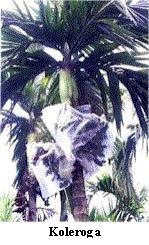
Koleroga is a major disease of arecanut causing serious losses. Spray Bordeaux mixture
1% on all bunches three times in a year, one just before the onset of southwest
monsoon and the rest at 40 days intervals. If monsoon season is prolonged give a
third spray. Use rosin soda adhesive to ensure tenacity of the spray deposit on
treated substrate. Remove and burn all fallen and infected nuts. Covering the bunches
with polythene bags is an effective alternate method of control
Bud rot (Phytophthora palmivora)
Remove and destroy affected spindle and leaves. In early stages of infection, scoop
out affected rotten tissues by making longitudinal side splits and apply Bordeaux
paste on the exposed healthy tissues or drench crown with 1% Bordeaux mixture.
Basal stem rot (Anabe) (Ganoderma lucidum)
- Isolate affected palms by digging trenches 60 cm deep and 30 cm wide around, one
metre away from the base and drench with calixin (0.08%) or copper oxychloride (0.3%)
-
Remove and destroy all severely affected palms and stumps of dead palms.
- Drench
the soil with 1% Bordeaux mixture before planting healthy seedlings.
- Discourage
growing of collateral hosts of fungus such as Delonix regia and Pongamia
glabra in the vicinity of gardens.
- Apply 2 kg neem cake per palm.
-
Avoid flood irrigation and water flowing from infected palms to healthy palms.
Yellow leaf disease
Maintain the garden properly to keep affected palms in a healthy condition by adopting
recommended manurial, cultural, plant protection and other management practices.
Improve drainage conditions in the garden.
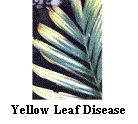
Disease management
- Apply the recommended dose of fertilizers.
- In addition to the above, apply
160 g of rock phosphate per palm in the affected garden.
- Apply organic manure
@ 12 kg each of compost and green leaves per palm per year.
- Provide irrigation
during summer months
- Avoid water stagnation in the garden by providing drainage
facilities.
- Grow cover crops in the garden.
- When only a few palms are
affected in a garden, remove them to prevent further spread of the disease.
-
Adopt need based plant protection measures against pests and diseases.
Band disease
Improve soil conditions by loosening hard soil strata, if present, by providing
good drainage. Adopt adequate control measures against spindle bug, mealy bugs,
scales and mites. Where the results of the above treatments are not found satisfactory,
apply powdered mixture of copper sulphate and lime in equal quantities @ 225 g/palm
twice a year at the base of affected palms. Application of borax @ 25 g/palm has
been found to have an ameliorative effect.
Collar rot of seedlings
Improve drainage conditions in nursery beds and gardens. Drench spindle and base
of seedlings with 1% Bordeaux mixture in disease affected nursery or garden.
Dieback of inflorescence
Remove affected inflorescence immediately. Spray zineb (4 g in 1 litre of water)
or mancozeb (3 g/l) twice, once just after female flowers are set and again 15-28
days later. Aureofungin solution at 100 ppm concentration is also effective in controlling
the disease.
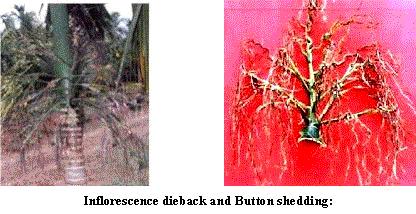
Stem bleeding
Palms in the age group of 10-15 years are more prone to this disease. Symptoms appear
on the basal portion of the stem as small discoloured depression. Later, these spots
coalesce and cracks develop on the stem leading to disintegration of the fibrous
tissues inside. With the progress of the disease, a brown exudate oozes out from
these cracks. High water table predisposes the palm to this disease.
Improvement of drainage and root feeding of 125 ml tridemorph (1.5%) is suggested
as control measure against this disease.
Sun scorch
Protect palms from southwest sun by wrapping stems with areca sheath or white-wash
the exposed portion. Provide reinforcement to palms showing stem fissures. Grow
tall, quick growing trees on southern and western sides of garden.
Nut splitting
This can be considered as a physiological disorder than a disease. Palms in the
age group of 10-25 years are more susceptible. Symptoms are premature yellowing
of the nuts when they are half to three-fourth mature. Later splits develop at the
tips, which extend longitudinally exposing the kernel. Sometimes kernel also show
splitting and malformation. Rarely the kernel inside may exhibit splitting without
visual symptoms on the husk, resulting in nut fall. Hyper nutrition or sudden flush
of water after a period of drought or insufficient moisture in the soil is the probable
cause (s) of the disease.
Improvement of drainage in ill drained gardens and spraying of borax @ 2 g/litre
of water are found effective in reducing the disease incidence.
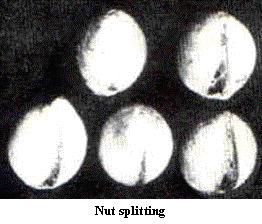
|
|
Harvesting & Processing
|
|
Top
|
|
Arecanut has been widely used in South and South-East Asia and the Pacific Ocean
Islands. While its primary use has been as a masticator, it is also finding use
among the local population in native systems of human and veterinary medicine, in
certain religious and social functions. Other parts of the arecanut palm like sheath,
stem, leaf, etc. are used in farms and households for manuring, packaging, construction
etc.
Harvesting of the arecanut is done by skilled climbers who cover about 50 -100 palms
in a day. Mechanical arecanut palm climbing device is available for easy climbing
the palm by any unskilled persons. The stage of harvesting depends on the type of
product to be prepared. There are two main types viz., kalipak, prepared out of
immature green nuts, and chali prepared from ripe nuts. In each case, the maturity
at which the fruit is harvested and the season of harvest affects the quality of
the processed nut considerably.
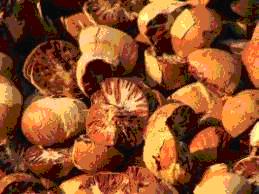
Preservation of arecanut with husk
Several age-old and crude methods are followed for preserving arecanut to keep the
moist chewing feel. Fresh ripe arecanut is used for chewing in Assam and Kerala.
In Kerala the fresh ripe fruits are stored in water and are known as ‘neetadaka’.
The nut contains mainly polyphenols, polysaccharides, fibre and fat. The husk contains
easily fermentable substances such as sugars and pectins. These are easily attacked
by bacteria when stored in water. The husk is loosened and the bright orange color
is lost. Because of fermentation foul smell is produced which penetrates into the
edible nut. In Assam fresh ripe arecanut is stored in pits. The husk gets attacked
by fungus and the fat and polysaccharides from the core is eaten away by bacteria.
The nut is thus rendered unsuitable for consumption.
To avoid the problems occurred during the preservation of fresh ripe arecanut in
garden fresh condition, a method of preserving fresh ripe arecanut by steeping in
mixed preservative solution has been developed. It consists of washing freshly harvested
areca fruits in chlorinated water to remove the adhering dirt. The fruits are then
blanched in boiling calcium chloride (0.2 %) solution. This treatment reduces microbial
load, destroys the enzymes and preserves the firmness of the husk. The fruits are
then kept immersed in a solution containing 0.1 % sodium benzoate and 0.2 % potassium
matabisulphite acidified to a pH of 3.5 to 4.0 using hydrochloric acid. The fruits
can be preserved in fresh ripe condition for 10-12 months. Fresh bright colour and
firmness of the skin are maintained. Stored fruits will be free from foul smell
without any significant changes in the constituents.
Drying of ripe nuts:
Fresh ripe areca fruits are dried in the sun by spreading in single layers for 35-40
days. The fruits are turned over at regular intervals to ensure uniform drying.
To facilitate uniform drying, some times the outer skin is peeled off. Later on
they are dehusked and sent to market. Whole dry nuts are known as ‘Chali’ or ‘Kottapak’.
The well known grades of ‘chali’ in descending order of size are ‘moti’, ‘Srivardhan’,
Jamnagar’ and ‘Jini’. Other characteristics which are valued are uniformity in size,
absence of immature nuts, surface cracking, husk sticking, fungus and insect attack
and good cutting feel, inside structure and taste.
Lack of attention during drying, unexpected rains and unsuitable wet drying yards
contribute to onset of fungal infection and result in a poor quality final product.
In Kerala and Assam harvesting season coincides with the monsoon and sun drying
is difficult. The main areas producing ‘chali’ nuts are Karnataka, Kerala and Assam.
Bangladesh, Malaysia and Sri Lanka also produce ‘chali’ nuts.
To facilitate drying, areca fruits are cut longitudinally into two halves and then
dried in the sun. Later they are scooped out and sent to market. This half-cut form
is known as ‘parcha’. It is produced mainly in Kerala and Karnataka. In Karnataka
its production is concentrated in South Kanara, Sirsi and Kumta area. In Kerala
its production is confined to Kasaragod, Nedumangad and Kottayam areas. Small quantities
of this type are produced in Assam, Maharashtra and West Bengal. In West Bengal
they are processed in parts of Cooch-Bihar and Jalpaiguri districts.
A mechanical through-flow drier is available for making ‘chali’ and ‘pacha’. Drying
can be completed in about 60-70 hrs spread over 7-8 days at progressively increasing
temperatures between 45-700 C. The drying schedule consists of successive 8 hr.
drying period followed by 16 hr. equilibration outside the drier. The parts of the
drier are a drying chamber with four perforated trays, a heat exchanger, fuel furnace
and a centrifugal blower. ‘Kalipak’ can be conveniently dried using this drier.
Small holders’ multipurpose dryer, using agricultural waste as fuel developed by
CPCRI can be used for drying arecanut. About 150 kg of arecanut can be dried in
this dryer in 100 hrs (10 days).
Storage of nuts:
Lack of proper drying yards, improper spreading and turning of nuts and exposure
to unexpected rains during the drying period lead to microbial infection of the
husk as well as kernel. Elimination of soil contact by the harvested nuts is beneficial
in reducing nut infection since it is the prime source of infection. Harvested nuts
treated with copper oxychloride showed less infection. Steeping the nuts in Bordeaux
mixture followed by drying on cement floor reduced the percentage of infection significantly.
Polythene lined gunny bags can be used with advantage over plain gunny bags for
storing nuts. Storage of arecanut in air tight bins also minimizes the fungal infection.
Insect damages by feeding on the inner central core and due to this, holes appear
on the surface of the nuts. The insect damage is maximum during the rainy months
when the humidity is high and minimum during winter and summer months. Arecanut
beetle (Cocotrypes carpophagus Horn) is the most important storage pest
of arecanut. The damage is mainly caused by adult beetles, which bore into the nuts
and feed on the inner contents. The infested nuts show holes of 0.6-1.0 mm diameter.
Both adults and grubs of coffee bean weevil (Araecerus fasciculatus D.)
have been reported to damage stored arecanut. Infested nuts have holes 1.5-2.5 mm
in diameter. Unhusked nuts with intact perianth are not infested by this insect
even after one year of storage. Cigarette beetle (Lasioderma sp.) is a
widely distributed storage pest infesting stored arecanuts throughout the year.
Both the adult and grubs damage the nuts and make them as powder. The caterpillars
of Rice moth (Corcyra cephalonica) construct galleries of silk and frass
over stored nuts, remain within and feed on them.
Dehusking
A simple dehusking devise has been standardized by CPCRI., Kasargod.
The out turn with this devise is 60 kg of husked nuts in the case of
dry nuts and 30 kg in the case of green nuts. The cost of the devise is about Rs. 250
Kalipak
Areca fruits of 6-7 months maturity are used for making this important class of
processed arecanut. The main processing centers are Karnataka and Kerala. The outer
skin of the husk will be green in color and the immature nut will be soft. The processing
consists of dehusking, cutting the soft nut into pieces, boiling the cut pieces
with water or a thin extract from a previous boiling, ‘Kali’ coating and drying.
Depending upon the number of cuts, different types representing pieces of various
sizes and shapes are recognized. ‘Api’ or ‘unde’ is the type which is processed
without any cutting. ‘Batlu’ or Ottavettu’ is cut transversely into two halves.
‘Choor’ is produced after several longitudinal cuttings. It is further divided into
sub-groups namely ‘mukkachoor’, edachoor’, ‘pettichoor’ etc, in the descending order
of thickness. Cutting the nuts both transversely and longitudinally 3 to 4 times
produces ‘Podi’. ‘Erazel’ and ‘Chalakudi’ are thin slices produced by slicing the
nuts transversely or longitudinally.
During the boiling operation, the same water is used for boiling 2 to 3 batches
of arecanuts. The extract so obtained is concentrated to get ‘Kali’. After boiling,
the pieces are coated with ‘Kali’, which imparts a good glossy appearance. In interior
Karnataka the boiling and ‘kali’ coating operations are combined into single operation.
The cut nuts are boiled in a thicker extract called ‘Chogaru’. ‘Lylon’ is an unboiled
variety made from green arecanuts. The nuts are cut into 5 or 6 discs transversely
and dried without kali coating. The nuts will be slightly more mature than those
used for ‘kalipak’. Tamil Nadu and Andhra Pradesh are important consuming areas.
The grades in increasing maturity and therefore decreasing grade are ‘Chittanum’.
‘Virivu’ and ‘Kora’. ‘Nayampak’ is also unboiled type and is made from immature
arecanuts after cutting once transversely and drying.
Both sun drying and oven drying are practiced by ‘Kalipak’ processors. A well dried
product with a dark brown colour is preferred. Other desirable qualities in ‘Kalipak’
are crisp chewing feel, glossy appearance, a well toned astringency and absence
of over mature nuts.
Sagopalm nut is used for adulterating ‘Kalipak’ samples. The cut pieces have a similar
cut surface and are coated with ‘kali. The chemical analysis revealed that sagopalm
nuts have lower polyphenol and fat contents but have higher polysaccharides and
fibre contents. Other adulterants used after ‘kali’ coating are sweet potato and
tapioca and they are comparatively easier to identify.
Scented Supari:
There are many varieties of scented suparis. The processing consists of breaking
the dried nuts into bits, blending with flavour mixture and packaging. Roasting
of bits in oil or ghee is also practiced. Batlu adike is mainly used for making
scented supari. In North India scented supari is made from ‘Chali’ nuts in addition
to those made from ‘Kalipaks’. The chali supari is more popular. About 75 per cent
of the marketed produce is consumed after processing either as kalipak or chali.
The flavoring varies depending on the region and it is a closely guarded secret.
Rose essence is used in most of the cases. Coconut grating which were used in earlier
days are now avoided as they get fungal infection.
Taste characteristics of nut:
Astringency is the characteristic taste of arecanuts. Polyphenols, which are present
abundantly in it, are responsible for this. Astringency is felt as a contracting
and drying sensation. The astringent characteristics in arecanut decreases with
maturity.
Colour development on chewing
The chewing of arecanut with betel leaf and slaked lime is very popular in India
and neighboring countries. In addition to the stimulation and pleasant taste, chewing
results in bright red colour of the mouth. Catechin turns brilliant red immediately
after addition of alkali (pH 10) which gradually turns reddish brown on keeping
for more than two hours. Similarly, the leucoanthocyanidins, which become dark red
initially, turn dull brown in about two hours and pale brown on keeping over-night.
The polymeric proanthocyanidins, which contain mostly leucocyanidin units also behave
similarly. The colour change of all the compounds at pH 8 is basically similar though
rate of change is different.
|
|
Alternative Uses & Waste Utilisation
|
|
Top
|
|
Tannins:Tannins are obtained as a by-product from the process of preparing immature
betel nuts for masticatory purposes. It was found that tannic acid from the nut,
when mixed with ferrous sulphate in warm distilled water gave black writing ink
of acceptable quality. He used immature fallen nuts for this purpose. Other uses
of tannin are as adhesive in plywood industries and as a textile dye.
Fats:The nuts contain 8-12 per cent fat. Fat from arecanut, can be extracted by
solvent extraction using hexane. Areca fat has comparable characteristics with hydrogenated
coconut oil. Areca fat can be made edible by refining with an alkali. The fat could
be softened by fractional crystallization using hexane (25ºC) and randomization
using sodium methoxide, which gave products desirable for use as confectionery fat.
Simple blending of areca fat with butter fat and cocoa fat at 3:1 ratio followed
by interesterification of areca fat and cocoa fat at 1:1 ratio gave good products
acceptable in confectioneries.
Arecanut husk:
It is the outer cover of areca fruit. It constitutes 60-80 per cent of the total
volume and weight of the fruits (fresh weight basis). It is now being largely wasted
except for being used as an inferior fuel and mulch. Several processes have been
developed for utilization of areca husk for making hard boards, plastic and brown
wrapping paper. Areca husk is used as a substrate for mushroom cultivation. Arecanut
husk fibre is generally longer than woolenised jute, goat hair or coir fibre. About
50 per cent of arecanut husk fibre is finer than other fibres and the remaining
50 per cent of fibre is coarser than those fibres. The tenacity value of arecanut
husk fibre is comparable with that of goat hair and woollenised jute. Wet weight
of arecanut husk fibre is comparable with that of other fibres. The weight and thickness
of all fibre reinforced plastic sheets are comparable. The proportion of fibre in
the fibre reinforced plastic sheets varied between 7.6 and 9.9 per cent. The proportion
of arecanut husk fibre is higher (9.12 per cent) in comparison with that of glass
fibre (7.9 per cent), though the thickness and water swelling ie, increase in weight
of the sheets by immersion in water for 20 days, values are same.
Areca leaf sheath:
Leaf sheath is yet another raw material obtained from the arecanut palm. In a year
palm sheds 5-6 leaves. A process has been developed for making plyboards from areca
leaf sheath. These boards can be used for making suitcases, fileboards, and tea
chests. Leaf sheath cup making machine is available in the market for making arecanut
leaf sheath cups of different sizes and shape.
Arecanut leaf sheath was found suitable for making plyboards. Two plies of processed
arecanut leaf sheaths in combination with an ordinary wood veneer as core glued
with urea formaldehyde resin are used for making the plyboards. Leaf sheaths obtained
from the farm are highly heterogenous having variations in structure, shape and
thickness. The rear end is thicker and the two edges are thinner. The thickness
at the center ranges from 3.0 – 8.5 mm (average 5.0 mm). A comparatively homogenous
piece of fairly uniform thickness and size 50-65 x 20-25 cm can be obtained if a
piece of about 10 cm length from either sides along the grain direction, 5 cm from
the distal and 10-15 cm from the end across the grain direction are trimmed out
from the sheath. Further, to get a flat sheath of uniform thickness and to remove
the buck lings of folds, the sheath is flattened under pressure and heat. For this,
the sheaths are soaked in water to about 75 per cent moisture and then pressed for
30 min in a hot Plate press at 4 kg/cm2 pressure and 110ºC temperature. This process
gives flat sheaths of 1.0-1.5 mm thickness with about 12 per cent moisture. To prevent
fungal growth on the sheath surface, it can be soaked in 1 per cent copper sulphate
solution for 24 hr before pressing. The pressed sheaths are then air dried for one
hour or longer. The arecanut leaf sheath plyboards made with two veneers of areca
sheaths as the faces and one veneer of even an ordinary wood species like Mango
as core ply and bonded with Urea formaldehyde resin make commercially acceptable
boards with average dry and wet glue shear strengths of 50 kg and 12 kg respectively.
Arecanut stem and leaf:
Arecanut stem forms a useful building material in the villages and is widely used
in arecanut growing area for a variety of construction purposes. The leaves are
good source of organic manure. Their approximate composition is N2 (0.94 per cent);
P2O5 (0.096 per cent) and K20 (1.00 per cent).
Utilisation of waste of arecanut plantation for mushroom
production
In India, the cultivation of mushrooms is limited to three species viz., white button
mushroom, paddy straw mushroom and oyster mushroom. Oyster mushrooms are the ideal
ones for the arecanut sector due to its ability to utilize lignin rich arecanut
wastes and the climatic conditions prevailing in plantations are also ideal for
its growth. Oyster mushrooms, known as wood fungi, are endowed with ligninolytic
and cellulolytic properties to utilize a wide range of agricultural residues as
substrates for growth and fruit body production. Paddy straw is the most widely
used substrate for its cultivation. But its increasing cost and decreasing availability
are factors, which prompted research workers to look for alternate substrates for
oyster mushroom cultivation. Conditions have been standardized for cultivation of
oyster mushrooms using arecanut leaf sheath and bunch waste. The steps in oyster
mushrooms cultivation include development of spawn, substrate preparation, spawning,
incubation for spawn running and opening and maintenance of beds for cropping.
Spawn, the vegetative seed of the fungus, can be obtained either from research institutions
or can be prepared with adequate training. An efficient and stable strain of Pleurotus
isolated from sporocarps should be used for spawn preparation using grains such
as wheat, sorghum, maize, jowar or paddy straw as substrates. Pasteurization of
substrates is necessary to avoid contamination and to obtain higher yield. Steam
sterilization, hot water treatment and chemical sterilization are the effective
methods. Steam sterilization at 1.02 kg/cm2 pressure in an autoclave for one hour
is an efficient method of sterilization. Hot water dip of the substrate at 80°C
for 60-120 minutes is another method, which can be easily adopted. Chemical sterilization
method involves treatment with formalin and bavistin in substrate soaking water
for 18 hours. Arecanut bunch waste and leafstalk are pasteurized by soaking in a
solution of 500 ppm formalin + 25 ppm bavistin.
Polyethylene bag method is the commonly followed method of cultivation. Polyethylene
bags (150-200 gauge) of 66 x 45 cm size are punched to facilitate cross ventilation.
Spawning is done by multilayered technique using 3 per cent spawn. For spawn running
and cropping, the filled up bags are incubated in cool dark place. In 15 to 20 days
white thread like mycelium covers the entire substrate and the whole mass turns
into a solid cylindrical structure. At this stage the polyethylene bags are ripped
open and incubated for cropping by hanging or by stacking on the shelves of mushroom
house with watering daily twice after two days of opening of beds.
Low cost mushroom sheds can be built with coconut/areca stem and plaited coconut
leaves inside arecanut plantations. Multilayer rack can be prepared with coconut/
areca stem inside the shed to keep the spawned substrate for spawn running and cropping.
Ventilators with insect proof nets are to be provided on all sides of the shed.
Mushroom production is 69 per cent and 49.8 per cent in a cropping period of 47
to 52 days in arecanut bunch waste and leaf sheath, respectively.
|
|